
Hair. The Final Frontier. People style it, color it, talk about it, change its shape, make it bigger, make it smaller, and make it a 7 billion-dollar a year industry! And lots of people lose it.
Hair is a part of how we look at ourselves, and how others sometimes look at us. The things that make it grow and what makes it fall out are interesting and seemingly mysterious. This site is set up to look at the different aspects of hair, from how it grows, to how it falls out, to what treatments are available for those that don’t want to part with it (no pun intended). We will also examine the different causes of hair loss, from male pattern baldness to drug-induced hair loss, and provide readers with some hints on how to keep their hair healthy. Along the way, we hope to pass along some perspective and let people see hair for what it is: some strands of protein on ones head and body, and not a marker for wealth, intelligence, virility, or anything else that’s really important in life!
(Patrick Stewart has, unfortunately, neither reviewed this site, nor condoned its content. He does, however, have androgenetic alopecia. Read on…)
ANATOMY
We have approximately 5 million hairs on our body. Of these, about 150,000 (more if you’re blond, less if you’re a redhead) are found on our scalp. The only parts of our body where there are no hair follicles are the palms, soles, lips, tip of the penis, clitoris, and labia minora
Each hair grows from a pocket in the skin called the hair follicle. During its growing phase, the follicle has a bulb-shaped bottom, the center of which is called the dermal papilla (P).The papilla is fed by very small blood vessels, which bring it food and oxygen and take wastes away. The papilla is highly sensitive to hormones. It is here that hormones and chemicals secreted by your body (or injested as a medicine) work on the hair, making it grow faster, slower, or not at all.

The color of our hair is determined by pigmented cells growing at the dermal papilla. These cells (melanocytes), contain a chemical pigment (melanin) – stained dark purple in this photo. The amount and density of melanin in these cells determines the exact color of your hair. There are two types of melanin, one coloring hair brown to black (eumelanin) and one coloring hair blond to red (pheomelanin). The color, shape and thickness is in a large part determined by genetics”¦just look at your folks!
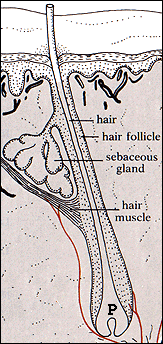
The hair follicle is a sac-like structure that surrounds the hair root. It is found below the skin, and has very small blood vessels giving it nourishment. Sebaceous glands surrounding the hair root secrete oil (sebum) while salt-water (perspiration) is secreted from nearby sweat glands (not shown). The sebum oil protects the hair and keeps it shiny and waterproof, while the sweat is a way for the body to cool down if it’s too hot.
The purpose of hair is to keep the warmth in. Warm-blooded mammals require a warm body temperature to survive(cold-blooded animals, like snakes and other reptiles, metabolize and survive at “room-temperature” and thus neither need, nor have, hair). The densely packed hair of mammals (fur) plays an important role in keeping warm. A tiny hair muscle attached to each hair follicle, called the arrector pili, contracts when in a cold environment (or when fearful). This causes the hair to be pulled downwards so it stands up straight (goose-bumps or gooseflesh), and warm air is actually trapped between each hair. This functions like a layer of clothing, keeping warmth in.

Humans, however, have lost most of our dense fur, so even though we still get goose-bumps, and our hairs can stand on end, the keep-warmth-in phenomenon no longer works.
Hair is actually composed of a protein called keratin. It’s the same protein found in our nails and in our skin. A strand of hair has three layers. The outermost layer is called the cuticle. It is transparent and acts to protect the inner layers. The innermost layer is called the medulla, and is composed of large baggy cells that may have a hollow-like appearance. Between these two layers is the cortex. The bulk and strength of hair is from this compact area of cells.
HAIR LIFE CYCLE
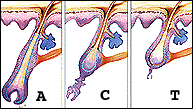
The life cycle of a hair is divided into three phases. The actively growing (Anagen) phase, the transitional (Catagen) phase, and the resting (Telogen) phase.
During the anagen phase, protein and keratin are continuously made. It is during this phase that the hair shaft is manufactured and pushed upward to its natural length. Not the large healthy bulb at the hair base. A hair’s anagen, or growth phase, lasts from 3 to 5 years, and represents what is occurring to about 90% of the hair on your head at any given time.
In the catagen, or transitional phase, there are chemical and structural changes in the hair follicle. The hair stops growing, and remains in this phase for only two to three weeks before moving into the next phase.
 |
 |
 |
|
Anagen
|
Catagen
|
Telogen
|
Finally, hair enters the telogen phase where it basically just sits on your head for about 3 months. Then, it falls out only to be replaced by the next budding hair in the anagen phase which begins to grow from the same hair follicle. These replacement hairs get finer and thinner as a person ages. In most settings of baldness, the hair follicle simply shuts down and refuses to put out more hair to replace the ones that have fallen out.
A person normally sheds up to 100 hairs per day. Hair growth occurs at about an inch per month, faster when it’s hot (summer) and slower when it’s cold (winter). This rate slows down with age, and shuts off in more and more hair follicles as time marches on. Things that influence hair growth include not only hormones, but nutrition, vitamins, emotional states, and many unknown factors.
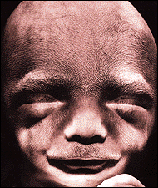
Hair growth starts before we’re even born. We don’t really know what triggers it, or what keeps it going. Perhaps it is a link to our genetic ancestor, the primate Our first hair, Lanugo (Latin for fine wool), begins to grow approximately 3-6 months after conception. It is usually shed before, or soon after birth and is replaced with the coarser hair we all know. The pattern of our hair (e.g., where our hair parts) is believed to be related to the formation of hair follicles as our skin is stretched over the developing fetus. There are many different patterns and possibilities of hair growth, though some are much more common than others (shown below).
After birth, different hormones affect the follicle allowing growth or causing hair follicles to move into the resting (telogen) phase. A hormone called dihydrotestosterone (DHT), a product made from testosterone, acts on the hair follicle causing growth to slow and ultimately stop. DHT only works on certain hair follicles that have the genetic predisposition to be shut off.
 |
 |
 |
Usually, these are on the front and top of our heads. An interesting fact is that castrated males (eunuchs – who do not make testosterone (and hence can’t make DHT) because they do not have testicles, do not have male pattern balding unless they are given injections of testosterone. If a castrated man gets these testosterone injections, they will immediately start losing hair in the classic horseshoe fashion (see the male pattern baldness section). Certain drug therapies against balding make use of this relationship of testosterone to DHT, as we will soon discuss.
CAUSES OF HAIR LOSS
With the hormonal changes of aging comes a decrease in the number of active hair follicles. Though this is an essentially universal change in all of us, a number of hormonal, genetic, or disease states make some of us lose hair earlier in life.
ANDROGENETIC ALOPECIA
The most common cause of hair loss is known as androgenetic alopecia, or male pattern baldness (in men), and female pattern baldness (in woman).
 |
|
MALE PATTERN BALDNESS
|
Male pattern baldness is something that 7 – 15% of American males experience by age 25, and almost 40% by age 35. It is a natural, age-related change in the body, and represents over 95% of all hair loss in men. The exact reason and cause of male pattern baldness is not known, though it is clear that our GENETIC makeup is a huge part of it. The HORMONE androgens discussed previously (like testosterone and dihydrotestosterone) also play a big part. Roughly put, the more androgens you have, the faster you lose your hair. The loss of hair follows a horseshoe-shaped pattern (shown in the graphic), with the hair on your sides and back of the head generally being left untouched. You can assess your chances of developing male pattern baldness by looking at your male relatives, starting with dad and grandfathers (most telling is your mother’s father’s hair pattern – if he has it, you are at high risk). The male pattern baldness genes can come from your mother just as easily, but may be less noticeable since it’s often slower to develop in women. Male pattern baldness often begins slowly at puberty, but may then come on very fast or not at all.
 |
|
FEMALE PATTERN BALDNESS
|
For woman, female pattern baldness is the most common type of hair loss (also called androgenetic alopecia). It affects about 20 million women in the US alone, and is highly correlated to GENETICS. It can begin at puberty, but is most often seen after menopause. As we discussed previously, male and female pattern baldness happens when hair that falls out is no longer replaced. Female pattern hair loss is generally a change to thinning hair rather than just falling out, and is more noticeable on the top of the head.
TELOGEN EFFLUVIUM (STRESS TRIGGER)
Whether it’s a death in the family, pregnancy, illness, crash weight loss program, or worrying about a huge asteroid hitting the earth, body stressors can affect the hair follicle. What is believed that the stressor causes a major change in a large portion of the hair follicles, moving them from the anagen growth phase to the catagen then telogen rest phase. The follicle then lets go of the hair that’s already there while refusing to provide a replacement. Known as telogen effluvium / deffluvium, it is the second most common cause for hair loss after androgenetic alopecia. Through an unclear set of neurochemical events, the hair follicle gets the message that the body needs all the resources it has for more important things than hair, like childbirth and nursing. It usually affects small, circular patches of the scalp in no apparent pattern. The good news is, when the stress goes, the hair comes back (about 6 months later).
Although hair loss can occur with the stress of any illness, it is also a particular symptom of many different diseases. Most differ in the pattern of hair loss, and almost never resemble Male Pattern Baldness. It’s also important to recognize that hair loss is seldom the first and only presentation of these diseases. Most hair comes back when the disease goes away or is adequately treated. Some of the diseases associated with hair loss are as follows: Addison’s disease, Hyperthyroidism (Hashimoto’s thyroditis), Hypothyroidism, Iron Deficiency, Scarring, Seborrheic Dermatitis, Secondary Syphilis , Systemic Lupus Erythematosus (SLE), and Vitiligo (there are others).
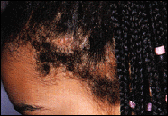 |
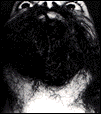 |
|
traction alopecia
|
traction alopecia
|
Two particularly interesting forms of hair loss are traction alopecia and trichotillomania. Traction alopecia is hair loss due to excessive and chronic pulling, or traction, on hair. It commonly occurs in people who braid or knot their hair. There is pronounced traction alopecia in the beard area of this Sikh man. In the Sikh religion, men do not cut scalp or beard hair. The beard hairs are pulled straight and then twisted and tightly knotted. Daily knotting often results in this form of traction alopecia.
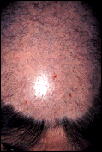
Trichotillomania is the intentional pulling out of otherwise heathly hair. Most commonly, it is a temporary habit of no consequence. Sometimes, however, it is a symptom of a psychiatric or serious emotional problem. Most often seen in children and young adults, the pulling out of individual strands of hair has been associated with thumb-sucking and other habitual rituals. Usually scalp hair is pulled, though eyebrows, eyelashes, or pubic hair may be involved. Often the pulled hair is manipulated in a ritualized way (such as wrapping around a finger) before being discarded.
ALOPECIA AREATA

Alopecia areata is the development of patches of baldness, usually in small circular areas of the scalp. It is relatively common, affecting about 1 out of every 100 people in the US population. It is generally thought to be autoimmune (where the body’s own cells and antibodies attack the body itself – in this instance the hair follicle, specifically the papilla/bulb area).This disease usually affects young adults, and occurs equally in men and woman (though it is more common in men in Italy and Spain). About 80% of people with alopecia areata eventually regrow most, if not all, of their hair. Many people, however, will have recurrent battles with this condition.
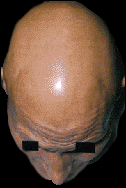
A severe form of alopecia areata is the total loss of scalp hair (alopecia totalis) and even sometimes the complete loss of all body hair (alopecia universalis). About 33% of those afflicted with these rare problems will grow back all their hair within a year, though again, recurrences do occur.
ANAGEN EFFLUVIUM (CHEMICAL DAMAGE)
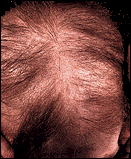
Like Telogen effluvium, this form of hair loss initially causes patchy loss of hair (which often then advances to total hair loss). In this form of hair loss, rather than just shutting down the hair follicle, a chemical actually kills the hair follicle and anagen hair. The most common example of this are the effects of drugs used to treat cancer. Chemotherapy is medicine that’s injected into the body to kill cancer cells. In effect, it’s really a poison that’s designed to kill more bad cells (i.e., the tumor cells) than good cells. One of the side effects is the poisoning of the hair follicle. The good news is, when the chemotherapy stops, the hair comes back (also about 6 months later).
Other drugs also can cause hair loss. Many medicines used to treat even common diseases can cause hair loss. Most do so by unknown mechanisms, and most of the drugs known to do this only cause hair loss in a small minority of patients. Click here for a list of the medications that are known to cause hair loss in a small percentage of patients. Obviously, be sure to you ask your doctor before discontinuing a medication as some of these medicines require a slow taper to avoid complications.
TREATMENT

Before discussing any “treatments,” its important to really ask yourself how important hair is to you. We’ve put “treatments” in quotes since hair loss in itself is not a disease, and does no medical harm to your body. So, are you willing to go through your bank account? Are you willing to possibly suffer side effects that could harm your body? Are you willing to undergo the discomfort and risks of surgery?
Instead of jumping to getting more hair, maybe we should know how to protect the hair we have. There are MANY products out there. Just because they are advertised does not mean they are good. In fact, more expensive products can sometimes be less effective than simple measures. Many products do not do anything at all! Here are some helpful facts about maintaining your hair:
” Choose a shampoo that’s not too rough or drying, and leaves your hair manageable, easy to comb, and glossy.
” Shampoo as often as you need to – contrary to what many hairstylists say, more shampooing does not mean more hair loss. In fact, shampooing regularly helps unclogs oily pores and dead skin cells.
” High priced and exotic ingredients usually do not mean better protection for your hair.
” Always rinse the shampoo thoroughly out of your hair, as it can leave a residue that can damage and irritate the scalp
” Conditioners lubricate your hair. Those that claim to “nourish” your hair usually don’t, since most molecules are too large to get into the cortex. Conditioners with benzalkonium chloride and/or cationic quaternary ammonium compounds generally give some protection. Added polymers, collagen, resins, silicones, and balsams probably don’t damage hair, and may make it look better. Many “extra-body” shampoos contain fats and oils to give that effect.
” Permanents, waved, straightened, or dyed hair are often damaged by these procedures.
” Blow dryers, curling irons, and rough towel drying can damage hair – natural, or soft pat drying is best. If blow drying, leave hair slightly damp.
” Brushing gently may increase circulation to the scalp, though whether this means anything to the hair follicle is unknown. Likewise, standing on ones head also may increases scalp blood flow, but there is no evidence this does anything.
” Avoid tight braiding and teasing (see traction alopecia)
” Avoid too much exposure to the sun, swimming pool chemicals, and wind as these may damage hair.
Although some companies will quote you studies of how people with more hair are looked upon as more successful, sexier, and more handsome, you should remember that most of those studies were done a long time ago, and paid for by the very companies which now want to sell you these expensive, and often ineffective, “treatments.” You should consider the search for hair replacement as cosmetic/plastic surgery. That said, may of our surfers still want to know what is available, so click the treatment options below (or in the left frame) to learn more about what is available right now.
 |
 |
 |
MEDICATION & REMEDIES

ROGAINE Minoxidil (Rogaine) is a very publicized liquid drug that’s rubbed on the scalp to increase hair growth. Originally developed as a blood pressure lowering drug, hair growth was found to be a then unwanted side-effect. It was introduced in 1988 by Upjohn, who has since sold about $150 million of it per year. It has been found to be relatively safe and is now available over-the-counter (OTC) (i.e., you don’t need a doctor’s prescription anymore). Below are some additional facts.
| Target Users | Young Males (20,s – 30,s) with recent onset of balding (< 5 years); not bald at sides |
| Best Effects | Small areas (less than 1 square inch) of top or frontal balding (not at sides of head) |
| Cost | $300 per year ($15 to $30/month depending on where purchased) |
| Length of Treatment | Lifetime commitment; it is recommended to try for 4 months to decide if it works, and must be rubbed on target areas twice a day, every day. |
| How it Works | Unknown, but it does increase blood flow by making the blood vessels bigger. Other drugs that do the same thing don’t work, however. |
| Effectiveness | It is not really clear how effective it is. Experiments that launched the drug reported moderate to marked hair growth in 39% or patients after 12 months, when compared to 11% who used placebo (essentially a sugar pill). This means that 61% of patients had no increase. Studies also suggested that Rogaine was more effective in preventing hair loss rather than promoting new hair growth. Less information is available on its effect on women. No information about the long-term effects, or about its safety in men over age 49 is available. |
| Side Effects | Headaches (in up to 40% of users), dizziness, itching, allergic reactions, heartbeat irregularities can also occur. |
| Availability | Now without a prescription – in your neighborhood pharmacy or over the Internet. You should, however, talk to your physician before you take it as there can be interactions with other medications. |
| Summary | minuses? 1. Side-effects 2. Cost (it’s not covered by any health plan) 3. Lifetime commitment: all hair gained is lost if treatment is stopped 4. Only for those who are younger, and have just started to experience hair loss 5. Questionable results 6. Somewhat messy to apply Pluses? 1. It works for a select group of patients. |

PROPECIA Finasteride 1 mg (Propecia) is a newer drug available for treating hair loss in MEN ONLY. This drug was originally developed to treat prostate enlargement (in higher doses) but was found not to be very effective for this problem. Luckily (for Merck, & Co.), it was found to be effective in some forms of male pattern baldness and has since been renamed and reformulated to treat hair loss. Propecia is a pill that’s taken orally.
| Target Users | MEN ONLY, who are younger (20’s to 30’s) with recent onset of male pattern hair loss (< 5 years), and who do not plan on fathering children; not bald at sides. |
| Best Effects | Top and crown (vertex) of head. Good at maintaining the hair you still have. |
| Cost | $500 – $1000 dollars a year ($50 – $80/month depending on where purchased). |
| Length of Treatment | Lifetime commitment; it is recommended to try for at least 3 months to decide if it works, and must taken orally once a day, every day. Do not take an extra pill if you skip a day. |
| How it Works | Propecia is believed to block the production of the DHT (dihydrotestosterone) from testosterone. DHT turns off susceptible hair follicles. |
| Effectiveness | Two main studies were done that lasted 24 months and involved 1,879 men aged 18 to 41 with mild to moderate, but not complete male pattern hair loss. These studies showed that for men with predominantly vertex (crown of head) hair loss, taking Propecia resulted in the following: Great Improvement: 5% of study participants Moderate Improvement: 31% Slight Improvement: 30% No visible hair loss: 33% Slight hair loss: 1% These studies showed that for men with predominantly vertex (crown of head) hair loss, taking Propecia resulted in the following: Great Improvement: 5% of study participants Moderate Improvement: 31% Slight Improvement: 30% No visible hair loss: 33% Slight hair loss: 1% For men with predominantly front and mid-scalp hair loss, Propecia did not work as well at improving growth , though it was still effective at maintaining hair count: Great Improvement: 0% of study participants Moderate Improvement: 4% Slight Improvement: 38% No visible hair loss: 53% Slight hair loss: 5% For men with predominantly front and mid-scalp hair loss, Propecia did not work as well at improving growth , though it was still effective at maintaining hair count: Great Improvement: 0% of study participants Moderate Improvement: 4% Slight Improvement: 38% No visible hair loss: 53% Slight hair loss: 5% |
| Side Effects | Propecia SHOULD NOT BE USED BY WOMEN OR CHILDREN because its been found to cause abnormalities in the developing genitals of male children. Women and children should not even touch the tablets, since Propecia can be absorbed through the skin (even though it has a protective coating, it can be easily crushed or damaged). Less than 2% of men complained of side effects. The most common side-effects related to sexual dysfunction, such as decreased libido (desire to have sex), problems with erections, and problems with ejaculation. These side effects resolved after stopping the drug. |
| Availability | By doctor’s prescription only. |
| Summary | minuses 1. Side-effects 2. Cost (it’s not covered by any health plan) 3. Lifetime commitment: all hair gained is lost if treatment is stopped 4. Only for adult MEN! Pluses 1. It works for a select group of patients. 2. It is quite good at maintaining the hair you still have. 3. Its a once-a-day pill that is easy to take. |
TOPICAL, HERBAL, & OTHER REMEDIES

People have literally tried thousands of things to stop baldness, non of which have apparently worked. From the ancient Egyptians putting animal fat on their heads, to drinking mandrake roots in medieval Europe, to castor oil, to chamomile, to Jujube oil, to Aloe, to Horsetail, to the many herbal shampoos in the health food store, if there was anything that really worked, it would already be on the 6 o’clock news. Until then, we can be sure people will keep trying. Remember this before you try something – find out what studies, if any, have been completed. Just because something is “herbal” or “natural” does not mean it works or is safe! Many herbal remedies that are beginning to be studies have been shown to have just as many significant side-effects as “drug company” medications. And, if a new “Miracle Cure” is found, see if it’s around in a few months before thinking of trying it. After all, miracles last longer than that! Watch for our Herbal Remedy Online Guide, which will evaluate the herbal & supplemental remedy market – coming soon!
101 HAIR REGROWTH LOTION This is a concoction from Asia, which reportedly works by increasing the blood supply to the scalp, and prevents clogging and malnutrition of the hair roots. It also reportedly has no known side effects. Keep in mind that no reported medical testing has been done on this lotion so far, and we don’t know what it is, how exactly it works, or how we should use it. Although the marketing department of the company that makes it promises arrival to the USA, it may very well be just another harebrained scheme. we strongly recommend avoiding this medication until efficacy and safety studies have been completed.
ANTIANDROGEN THERAPY This form of treatment decreases androgens (like testosterone) in an effort to prevent hair loss. CPA (cyproterone acetate) is currently used in combination with ethinyl-estradiol in the United Kingdom. In the USA, Spironolactone, a drug used to lower aldosterone levels, is the counterpart. Aldosterone is a hormone in the body that increases androgen levels. This drug must be used for 1 to 2 years before visible results occur. It’s recommended within 2 years of onset of hair loss, and patients must maintain high levels of vitamins and ferritin (a substance that stores iron). Spironolactone tends to disrupt the menstrual cycle and increases menstrual bleeding. It is not intended for men, as it decreases sex drive and increases voice pitch. Currently, there are not enough clinical data using spironolactone for hair loss to recommend this medication for this purpose.
NON-SURGICAL ADD ONS

These treatments work by adding hair or hair-like material to already existing hair to create the appearance of a fuller head of hair. These devices include weaves (as in, Hair Club for Men), which essentially tie and attach real or synthetic human hair onto existing hair. You are thus required to have some existing hair for the technique to work. These weaves also must be regularly “touched up” for the best effect. The same technique can be used on men and women, and is most commonly used for male and female pattern baldness. In some add-on techniques, hair can be taped to the skin with adhesives, or can be woven in with tunnel grafts. The cost for add-ons is quite variable and often depends on reliability of the company and quality of the product. In general, one can expect to spend somewhere between $750 – $5,000, or more. Often, regular follow-up for maintenance is necessary. Hair extensions work on the same principle, as do hair prosthesis. Wigs and toupees are more traditional options, and can also be of real or synthetic hair. Fill-in sprays are less popular alternatives, and are really just coloring the scalp and adding bulk which sticks to already existing hair to make it look thicker.
| Target Users | Anybody with hair loss, though toupees work best for those with vertex and front hair loss. Full wigs work for anybody. |
| Best Effects | Covering a small or large focal bald spot (as for androgenic alopecia) |
| Cost | Quite variable depending on the quality and service of the product and company. Often $1500 or more, plus a annual fee to be a member of the “club”. |
| Length of Treatment | Continuous, frequent “touch-ups” usually are required How it Works Real or synthetic hair is used to cover your balding areas. Variable techniques for attaching the prosthesis to your head depending on the product and “system” used. |
| Effectiveness | Variable depending on quality and workmanship of product. |
| Side Effects | Discomfort of the weave, potential traction alopecia, anxiety of having the hair piece or wig come off. |
| Availability | Products are relatively easy to find as many companies advertise and many hair stylists have favorite places to refer you. One needs money to obtain and maintain these products. |
SURGICAL HAIR TRANSPLANT
Some people try medical therapy and non-surgical therapy, and still do not have their expectations met. For those willing to endure the discomfort , side-effects, and have a significant amount of money to spend, surgery remains a good option.
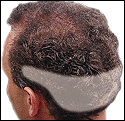
There are many different hair replacement surgical techniques. Most surgery works by taking hair “grafts” from a place that has hair (the usual donor site is pictured), and moving it to a place that doesn’t. The hair usually comes from the sides and back of the head, and is put on the top and front. This is commonly called hair grafting, punch grafting, plug grafting, or hair transplantation. A hole puncher device, or simply the removal of a strip of hair follicles, is usually used to remove different size areas from the back or sides of the head. These are then cut-up and transplanted into small areas in the bald area as macro and micro graphs (depending on the number of hair follicles present in the tiny bit of scalp tissue). Anywhere from 50 to 5000 of these plugs are done at each of up to 4 or more sessions.

The cost is quite variable depending on the procedure, but commonly runs $5000 to upwards of $15,000 PER SESSION. If repeat sessions are needed, they are usually done 3 months apart.
Other variations on this technique are used according to the desires and expectations of the patient and the experience of the surgeon. Many different surgeons have many different techniques each with a specific set of benefits and problems compared to other techniques.
Other, less common, surgical techniques include Flap Transplantation, where a large area or skin with hair is removed from the back/sides of the head, and attached at one end to the front (where it receives its blood supply). Scalp reduction is another surgical method, where saline balloons are placed under the skin with hair to progressively stretch it, followed by surgical removal of the bald part of the scalp and replacement with the stretched hairy skin. (Ouch!) This is used in combination with the other surgical techniques mentioned.
RESOURCES
Thank you for viewing our Hair Guide Online. This guide has helped you understand the inner workings of your hair, from how it grows, to how it falls out, to what treatments are available for those that don’t want it to fall out. We examined the different causes of hair loss and provided you with some hints on how to keep your hair healthy. We hope we have given you some perspective on your hair. As we’ve already noted, hair is some strands of protein on your body, and not a marker for wealth, intelligence, virility, or anything else that’s really important in life!

Hair is what we make of it. Some people decide it’s important enough to endure a lot of hardships over, and some don’t. Some people decide to date someone on the basis of it, and some don’t. Few people are happy or sad simply because of the status of their hair, though many of us have concerns or worries related to our hair, or lack thereof. And, although hair loss can be an important marker for disease or drug reactions, the overwhelming majority of balding and baldness is nothing to worry about. Really. Its just part of nature, and unlike many of the “treatments,” it does no harm to your body. There are certainly no shortage of example of people who were bald and yet possessed all the stereo-typed qualities a full head of hair is supposed to bring with it. For those whose concern and self-image is significant, both surgical and non-surgical treatments are available. The bottom line is this: work to be comfortable with yourself and who you are, and others will likely follow! Make it so!
For more information about Hair and Hair Loss, check out our recommended readings. Much of our information is from these detailed sources. Your family physician is also an excellent resource for information and help with your hair and health concerns. Don’t be scared, just ask.
” The Bald Truth: The First Complete Guide to Preventing and Treating Hair Loss (by Wendy Thompson)
” Alopecia Areata: Understanding and Coping With Hair Loss (by Spencer David Kobren)
” Hair Replacement Surgery: Textbook and Atlas (by J. C. Dardour)
Thank you again for checking us out. Please consider completing the anonymous survey before you leave.
We take your comments seriously!